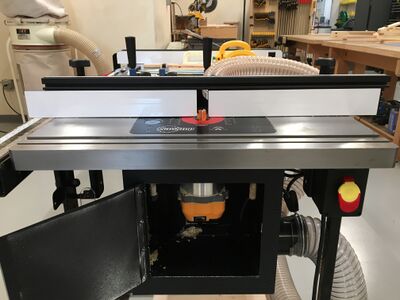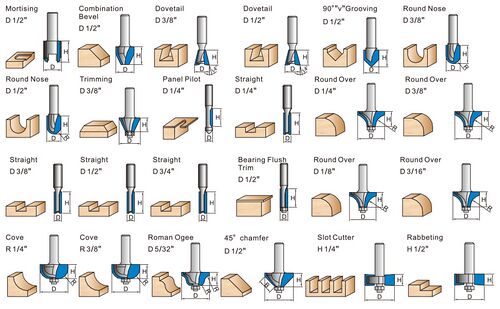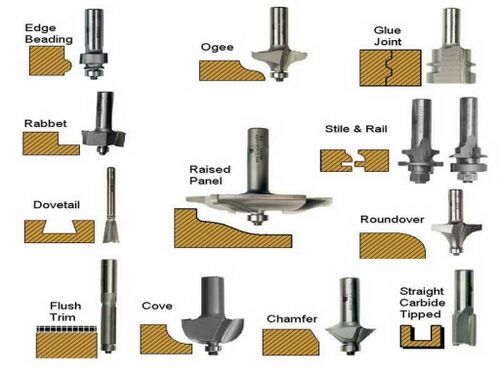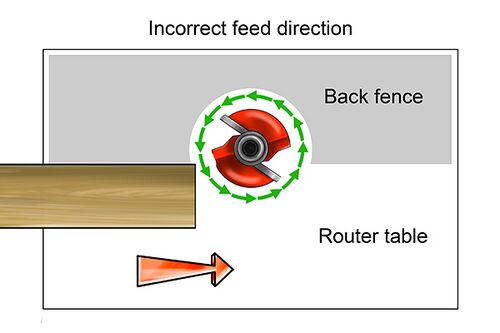Difference between revisions of "Router Table"
| Line 75: | Line 75: | ||
When using the fence, always feed the workpiece from the right side of the router table to the left. The bit spins counterclockwise. The rotation of the bit pushes against the feed direction and pushes the workpiece into the fence as the user feeds the workpiece from right to left. This is the proper way to make a controlled cut on the router table. It is dangerous to feed the workpiece from left to right because the router bit will pull the workpiece out of your hands and fling it across the room. | When using the fence, always feed the workpiece from the right side of the router table to the left. The bit spins counterclockwise. The rotation of the bit pushes against the feed direction and pushes the workpiece into the fence as the user feeds the workpiece from right to left. This is the proper way to make a controlled cut on the router table. It is dangerous to feed the workpiece from left to right because the router bit will pull the workpiece out of your hands and fling it across the room. | ||
| − | The feed rate is how fast the workpiece moves through the router bit. A feed rate that is too fast can cause the surface of the wood to tearout. In other words, the surface of the wood will be rough or chipped. A feed rate that is too slow can cause the wood to burn. | + | The feed rate is how fast the workpiece moves through the router bit. A feed rate that is too fast can cause the surface of the wood to tearout. In other words, you will get a poor cut and the surface of the wood will be rough or chipped. A feed rate that is too slow can cause the wood to burn. See the troubleshooting section for more info on burning. |
| − | |||
| − | |||
Be mindful of how much material you are removing in a single pass. If you attempt to remove too much material, you could end up straining the router motor, putting sideways pressure on the router bit, or cause tearout/burning on your workpiece. If you need to remove a lot of material, break it up into multiple smaller passes. If you are unsure how much material is "too much," ask a shop supervisor for assistance. Unfortunately, there is no magic number that indicates you are removing too much material. It's based on the cross-sectional area of the material you plan to remove, the shape of the router bit, the speed of the router bit, the hardness of the wood, and experience. | Be mindful of how much material you are removing in a single pass. If you attempt to remove too much material, you could end up straining the router motor, putting sideways pressure on the router bit, or cause tearout/burning on your workpiece. If you need to remove a lot of material, break it up into multiple smaller passes. If you are unsure how much material is "too much," ask a shop supervisor for assistance. Unfortunately, there is no magic number that indicates you are removing too much material. It's based on the cross-sectional area of the material you plan to remove, the shape of the router bit, the speed of the router bit, the hardness of the wood, and experience. | ||
Revision as of 13:00, 2 March 2022
Make: SawStop/Bora Portamate Motor
Model: RT-LFT 4-Post
Serial Number: 107015
Ace: Needed (Makerhub@georgefox.edu).
Location: Wood Shop
Description
A router table can be used to make custom moldings and make slots in workpieces. Router tables are extremely versatile in the types of cuts they can perform. Holes and channels of varying depths and nearly limitless shapes can be cut. The router table can also use special bits to cut bevels and chamfers along the edges of a workpiece.
Introductory Video
Things you can do with a router table
Documentation
Terminology
Each bit is made for a different job. The wood shop has a wide assortment, although less common types may be unavailable. It should be noted that different bit sizes and profiles will operate better at different speeds. A good rule of thumb for setting the router bit speed is: the larger the cutter the slower the speed. Usually the router table will be set to 20000 RPM. If you plan to use a larger bit and reduce the speed of the router, ask a shop supervisor for assistance.
- Fixture - Tooling you make or buy, which assists in the usage of a tool and helps yield a higher quality product.
- Soft Start - Electronic circuit used to slow the start up speed of a motor or power tool.
Training
Operation
Although the router table displays the SawStop logo, it does not have the SawStop technology. If your fingers come in contact with the spinning bit, the bit will not stop and it will be a very bad day for you.
Changing a Bit
Always unplug the router before changing a bit.
Always raise the router collet above the throat plate when changing bits. Insert the bit until the cutting edge touches the collet then pull the bit out about an eighth inch and finger tighten the collet. It’s important to allow an eighth inch of space between the bit and the collet. Router bits can heat up quickly when in use. This heat causes expansion, and the eighth inch space between the bit and the collet allows for this expansion. Router bits that are not installed properly can come loose while making your cut.
Use the two wrenches to tighten the locking nut on the collet.
Setting the Fence
When setting the fence, the router fence does not need to be exactly parallel to the bit for most cuts. This differs greatly from equipment like the table saw or bandsaw which have flat blades instead of a rounded bit. The important thing is to set the fence the proper distance away from the bit, and the bit will do the rest work.
Feed Direction
When using the fence, always feed the workpiece from the right side of the router table to the left. The bit spins counterclockwise. The rotation of the bit pushes against the feed direction and pushes the workpiece into the fence as the user feeds the workpiece from right to left. This is the proper way to make a controlled cut on the router table. It is dangerous to feed the workpiece from left to right because the router bit will pull the workpiece out of your hands and fling it across the room.
The feed rate is how fast the workpiece moves through the router bit. A feed rate that is too fast can cause the surface of the wood to tearout. In other words, you will get a poor cut and the surface of the wood will be rough or chipped. A feed rate that is too slow can cause the wood to burn. See the troubleshooting section for more info on burning.
Be mindful of how much material you are removing in a single pass. If you attempt to remove too much material, you could end up straining the router motor, putting sideways pressure on the router bit, or cause tearout/burning on your workpiece. If you need to remove a lot of material, break it up into multiple smaller passes. If you are unsure how much material is "too much," ask a shop supervisor for assistance. Unfortunately, there is no magic number that indicates you are removing too much material. It's based on the cross-sectional area of the material you plan to remove, the shape of the router bit, the speed of the router bit, the hardness of the wood, and experience.
Demonstration
Demonstrate you can safely setup the table router with a roundover bit. Remember to always unplug the router when changing tools or making adjustments to prevent an accidental turn-on situation. Perform a roundover cut on a piece of scrap wood.
General Procedure
The material you are cutting needs to be free from nails or foreign objects. The material should be at least 1/2" thick.
Safety
- Be aware of the cutter location on a router at all times as it is fairly exposed.
- Keep all body parts away from the cutter and make sure the motor has stopped before removing your hands from the handles.
- Any equipment/tool that you don't handle safely is the most dangerous tool in the shop.
- Don't attempt to use any router bits exceeding 1" in diameter.
- Never attempt to use the router without the base.
Certification
Troubleshooting
If you notice burning or dark coloration on the material it could be caused by feeding the cutter at too slow of a rate. A dull cutter can also cause material burning.
Maintenance
General maintenance
- Make sure cutter bits are clean.
- Remove and clean the collets as needed.
- Make sure any adjustment screws are tight.
Specific Maintenance Tasks
| Maintenance Procedure | Frequency | Done By |
|---|---|---|
| Sample | Sample | Sample |




